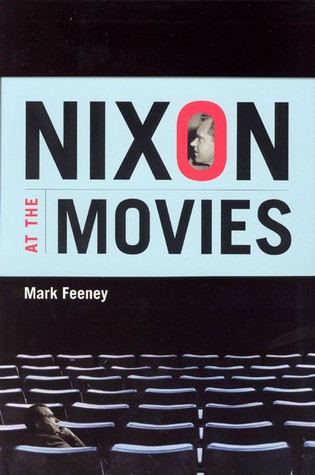If, indeed, the second half of the 20th century was, in our country, “the age of Nixon,” as Robert Dole declared in his eulogy for the man at Yorba Linda in 1994, then Mark Feeney has undertaken to demonstrate just how that age fits into the larger category of the 20th century itself as “the age of Film,” and to show as well not only what that meant for Richard Nixon but what it has meant for the rest of us.
Rehearsing Nixon’s life as an engagement with film may seem a superficial approach; yet, as Mark Feeney has done the job, the exposition is both ingenious and convincing. Born in 1913 only a few miles from Hollywood, Nixon literally grew up with the industry—but on the wrong side of it. Not only was he to marry a Hollywood extra whom he liked to take to the movies, but he was himself, as a young man, a talented actor as well as an orator and a debater. Yet Nixon was never comfortable with Hollywood, nor was he “at home” in his native state. Precisely, however, because Nixon was the least comfortable of men, the anonymous dark released something in him as he stared at the silver screen. He was never known to quit a movie once it started, no matter how bad it was. The quality of the film was, to him, beside the point when it came to moviegoing—a not-so-strange phenomenon in a film-besotted nation characterized by a culture of celebrity.
Yes, everyone knows that Nixon watched Patton three times before and during the incursion into Cambodia, but Mark Feeney is not one to leave it at that. Nixon’s affinities with General Patton were many and deep. Patton’s father had married the daughter of the first elected mayor of Los Angeles. Patton was different—in spite of, or rather because of, his background. In Patton, Nixon recognized a man who had also been condescended to by Eisenhower. Finally, Patton himself had once been the object of a movement to draft him for the 12th District congressional seat that Nixon won in 1946. In a remarkable revision of received ideas, however, Feeney insists that the Nixon who saw Navy service in World War II was no Patton even in fantasy but, rather, “Mr. Roberts,” as personified by that liberal icon, Henry Fonda. The faithful and diligent officer who ran “Nick’s Snack Shack” as he supervised the unloading of supplies performed meritorious if modest services in a situation of boredom and frustration, as the screen’s Douglas Roberts did.
Nixon was to view over 500 films during his presidency, while registering and even exploiting his enjoyment of John Ford, John Wayne, and Clint Eastwood. Nixon had no particular agenda so far as films were concerned, as long as they were conventional. But Feeney does have an agenda, and an unconventional one at that. His ventures into speculation are all the more appealing for their groundedness, for their imaginative engagement as opposed to fanciful triviality. “Mr. Roberts” is the most benign of his “alternative Nixons,” yet there are others. “Walter Neff” of Billy Wilder’s Double Indemnity (1944) is perhaps the most surprising, but the deeply Californian character, divided against himself, does foreshadow the conflicted Nixon who would bring about his own destruction. Still, the most remarkable of such characters must be “Jefferson Smith” of Frank Capra’s Mr. Smith Goes to Washington (1939), if only because, in reaction to the chaos caused by the Cambodian adventure, Nixon reenacted a scene from that movie by impulsively going out to the Lincoln Memorial to talk with disaffected students. This scene itself was later recreated in Oliver Stone’s Nixon (1995), ensuring that the relations of film and reality become vertiginously confused.
But there is much more to say about Nixon at the movies, and Mark Feeney not only says it all, he also says much that has not elsewhere been indicated, through allusions to Beavis and Butt-Head Do America (1996), The Big Lebowski and Fear and Loathing in Las Vegas (both 1998), Misery (1990), and Forrest Gump (1994). In Nasty Habits (1977), the Nixonian character is played by a woman, Glenda Jackson; but Nixon has been addressed by serious male actors as well, such as Rip Torn in Blind Ambition (1979), a CBS miniseries; Philip Baker Hall in Secret Honor; Anthony Hopkins in Nixon; and Dan Hedaya in Dick (1999). You pays your money, and you takes your choice.
If you also have a question about what the President watched and when he watched it, then Feeney has a list, and it makes for some interesting reading. Nixon viewed movies in the White House from 1969 through the late summer of 1974, as he was turning everyone else’s life into a bad soap opera that was to become a movie itself, All the President’s Men (the first film Jimmy Carter watched in the White House). The early 70’s weren’t great movie years (or great anything else years, come to think of it). So the best movies that Nixon watched were old ones from the best years of Hollywood, though he never seemed much to care. The list is suggestive, however, since various films seemed to contain a message for Nixon—messages that were not, apparently, received. Hard Contract, Hamlet, The Caine Mutiny, The Treasure of the Sierra Madre, and many another movies suggest certain interpretations that might have changed history. But if Nixon missed something here and there, Mark Feeney, expanding our sense of history and culture, has missed nothing.
[Nixon at the Movies: A Book About Belief, by Mark Feeney (Chicago: University of Chicago Press) 422 pp., $27.50]

Leave a Reply